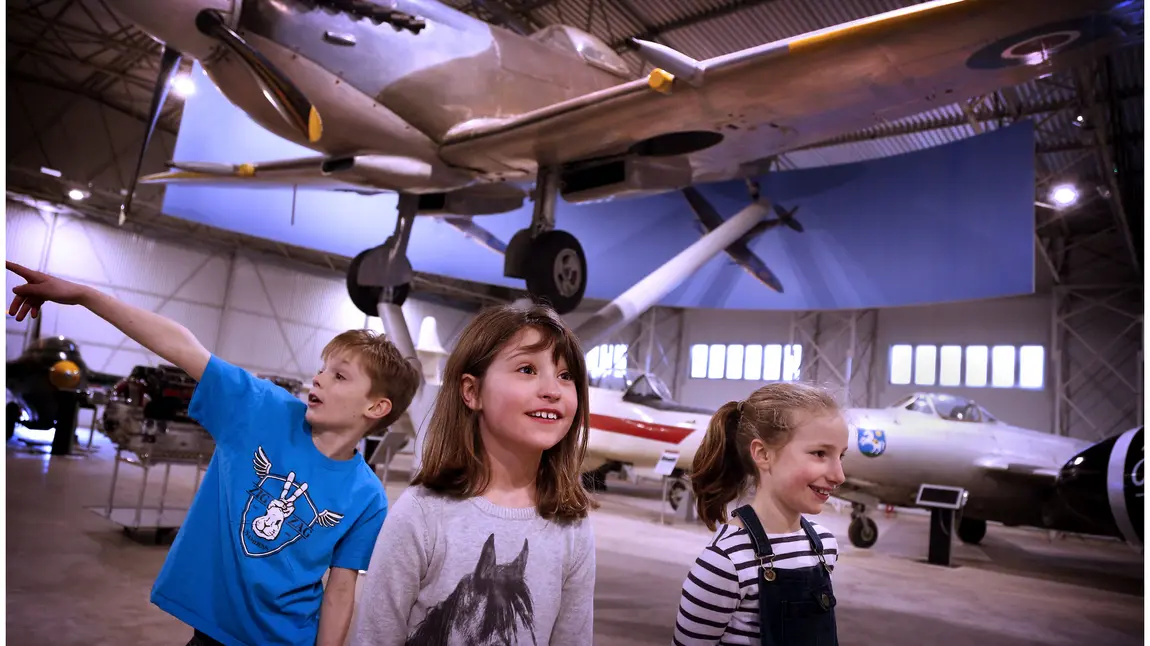Ready for take-off as Second World War hangars open following major redevelopment

One hangar displays military aircraft; the other commercial and leisure aircraft. Visitors will have the chance to immerse themselves in a century of aviation, experiencing the history and drama of flight as never before.
More than 30 aircraft will go on display, ranging from an iconic Supermarine Spitfire to an English Electric Lightning, the RAF’s first supersonic jet fighter, which could match the speed of Concorde. For the first time, smaller objects including uniforms, documents, photographs and weapons will be displayed alongside them.
Highlights of the military hangar include the oldest surviving Hawker Siddeley Harrier jump jet, which was the world’s first vertical take-off combat aeroplane and a rocket-powered Messerschmitt Me 163B-1a Komet, which was the fastest aircraft of the Second World War. The commercial and leisure hangar will display aircraft ranging from hang gliders and microlights to a Scottish Aviation Twin Pioneer and a Druine Turbulent light aircraft which was built as a labour of love in a home in Scotland in the 1960s.
Visitors can discover more about the stories of the people who piloted, flew in or worked on some of the aircraft on display via interactive touch screens displaying archive footage and specially recorded interviews. Visitors can listen to the stories of, among others, a mother who gave birth aboard a Britten Norman Islander Air Ambulance; a woman who piloted Spitfires during the Second World War and the late Captain Eric ‘Winkle’ Brown, the former RAF pilot who flew more different types of aircraft than anyone else in history. Visitors can listen to the stories of the late Captain Eric ‘Winkle’ Brown, the former RAF pilot who flew more different types of aircraft than anyone else in history.
Visitors will also be able to gain a deeper understanding of the developing role of aviation in the 21st century. A prototype of a BAE Systems ‘Striker’ helmet, used on the Eurofighter Typhoon aircraft, which allows pilots to see through the walls of their aircraft and home in on targets using just the movement of their eyes, will be on display, as will a DJI Phantom 2 drone which was made in 2013.
The hangars were built in 1940-41 and were originally designed to last just a few years. Part of the East Fortune Airfield Scheduled Ancient Monument, they have been restored, insulated and heated for the first time using an environmentally friendly ground-source underfloor heating system.
Funding for the £3.6million redevelopment includes a £1.3, grant from the Heritage Lottery Fund (HLF) and £1.8m from the Scottish Government.
Dr Gordon Rintoul, Director of National Museums Scotland, said: “The National Museum of Flight is one of Scotland’s top days out and these redeveloped aircraft hangars offer dramatic new experiences for our visitors. Spanning a century of aviation, the displays present our spectacular aircraft in new and dynamic ways, revealing for the first time the engaging stories of some of the people who flew and worked with them.”
Fiona Hyslop, Cabinet Secretary for Culture, Europe and External Affairs, said: “The refurbishment of these two iconic aircraft hangars and the new displays at the National Museum of Flight will significantly enhance the visitor experience at what is one of Europe’s major aviation museums. I’m confident visitors of all ages will enjoy interacting with the aircrafts and audio visual displays.
“The Scottish Government has contributed £1.8m towards this project. The funding included provision for a new heat source pumping system to be installed, making the hangars warm and inviting. Our commitment to the refurbishing and safeguarding of these iconic hangars will provide new displays and encourage new visitors to the Museum and East Fortune and continues to enhance National Museums Scotland’s reputation as one of Europe’s premier museums groups.”
Lucy Casot, Head of HLF Scotland, said: “Open the door of these two WW2 hangers and you are opening the door to history. The stories of incredible flying machines come to life in a way which will inspire, teach and let imaginations fly. Thanks to funds raised through the National Lottery, we are delighted to have played our part in the remarkable transformation of this unique collection. It will ensure that the National Museum of Flight continues to grow as a significant international tourist destination and a valuable education resource.”
Notes to Editors
National Museums Scotland looks after museum collections of national and international importance and provides loans, partnerships, research and training in Scotland and internationally. Our individual museums are the National Museum of Scotland, the National Museum of Flight, the National Museum of Rural Life and the National War Museum. The National Museums Collection Centre in Edinburgh houses conservation and research facilities as well as collections not currently on display.
Further information
- HLF: Shiona Mackay on tel: 01786 870638/07779 142890 and via email: shionamackay1@btinternet.com' or Jon Williams on tel: 0207 591 6035 and via email: jonw@hlf.org.uk
- National Museums Scotland: Alice Wyllie, Bruce Blacklaw or Susan Gray, on tel: 0131 247 4288 or via email: a.wyllie@nms.ac.uk